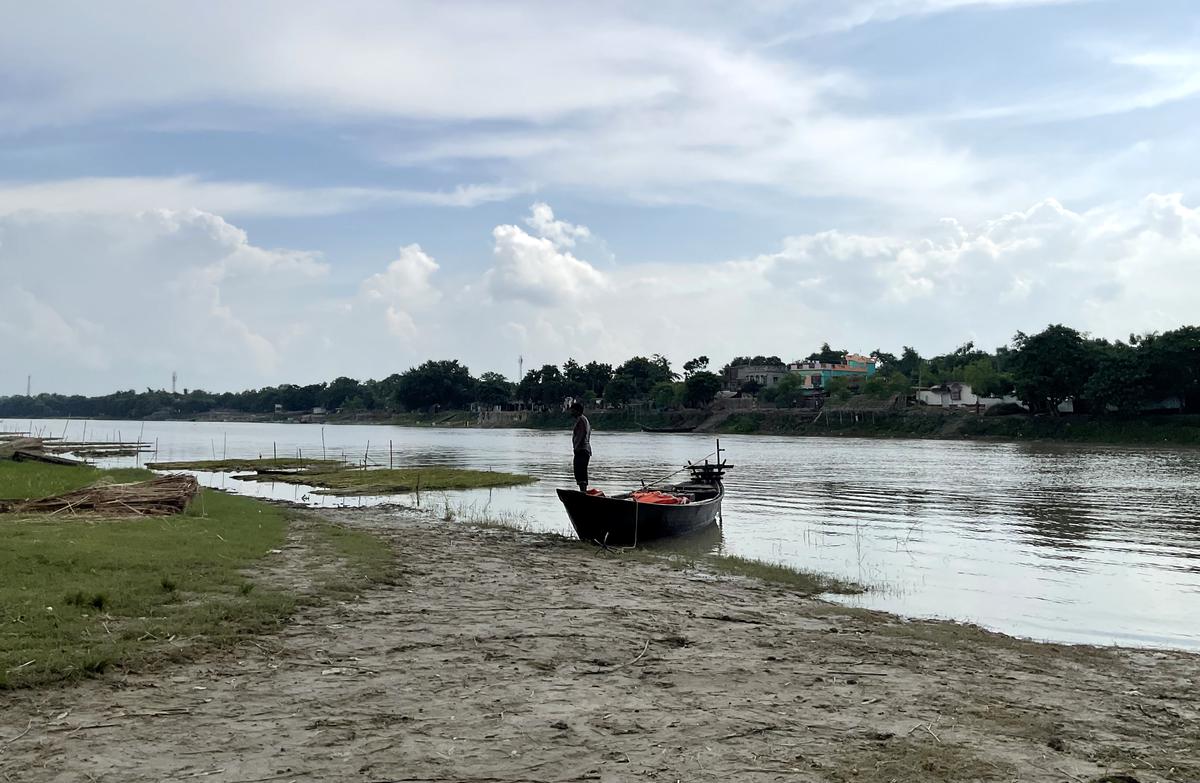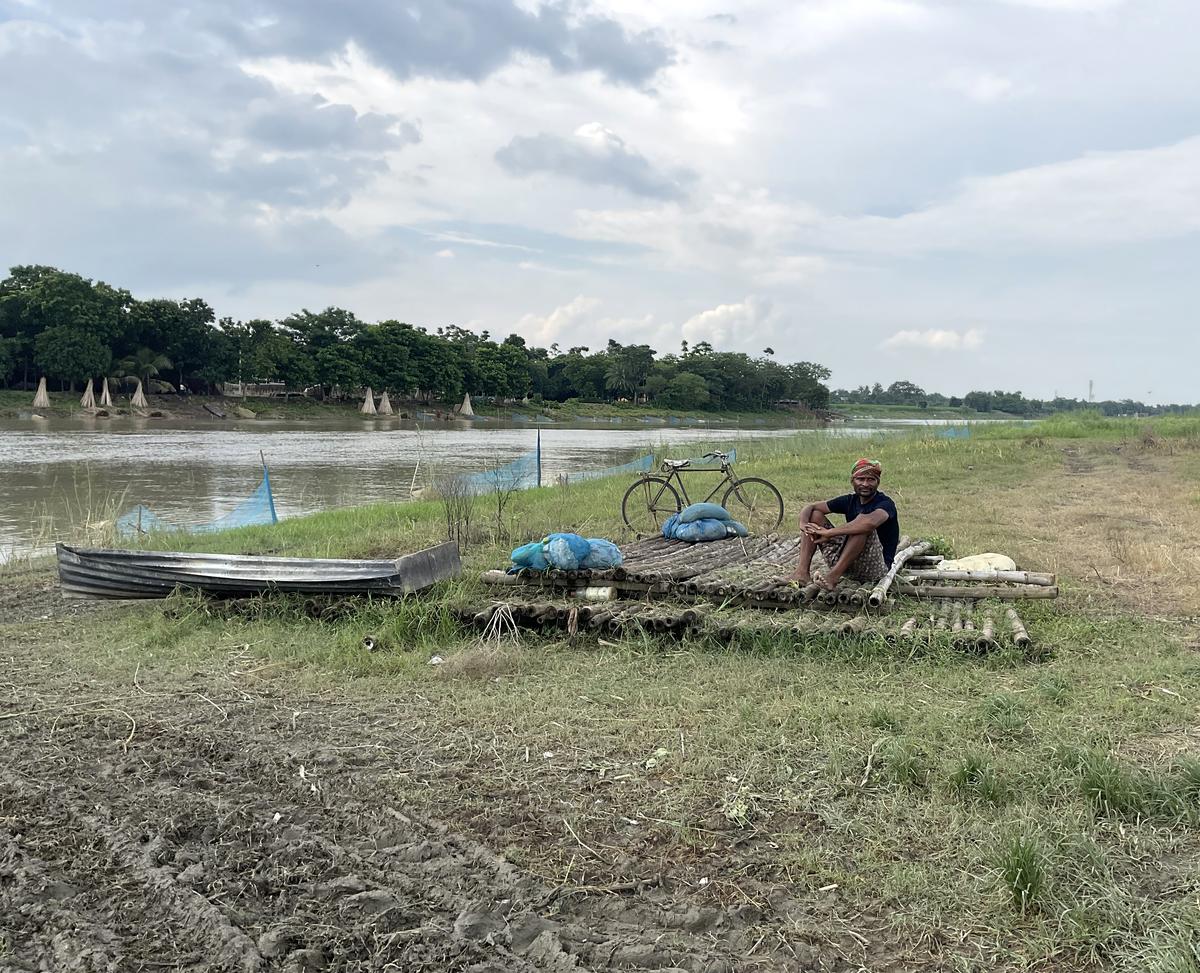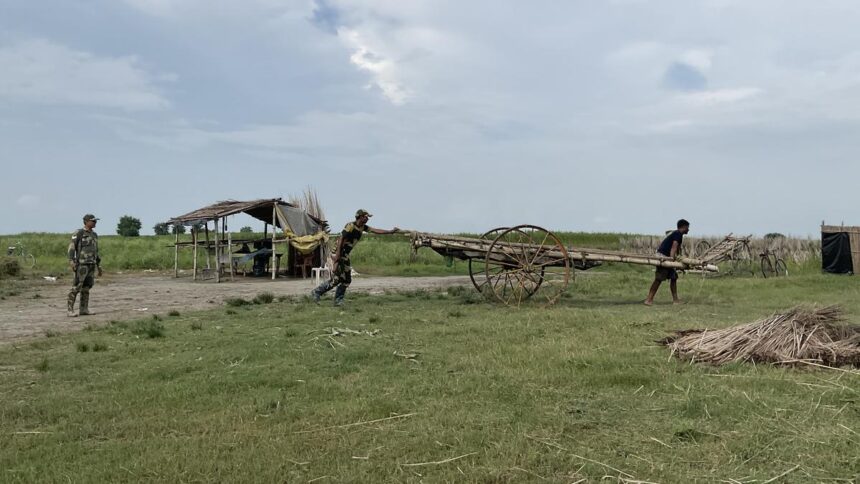Three days before violent protests erupted in Bangladesh forcing a regime change, India’s Border Security Force (BSF) declared a state of high alert along the river Padma, a geographical and political line between the two countries.
Pushing his bicycle, Mukbul Haque, 34, crosses the border outpost (BOP) at Kakmarichar in Murshidabad, beyond the line of BSF deployment. Here, amid a vast web of chars (river islands made of silt) and water bodies, he risks hours of torrential rain to spread fishing nets in the Padma, but was not sure if his efforts would yield a catch of hilsa. “Usually, the hilsa comes after July. The best time for a catch is at night, but many times people from Bangladesh get away with what is caught in our nets,” says Haque.
A pack of jackals runs past the thick vegetation and a board by the West Bengal Forest Department declares that gharials are being bred in the water. On his return to the border outpost, Haque hands over a diary to the sentry at the gate. The sentry records all the items that he is carrying. To cross the border outpost, Mukbul carries his Aadhaar card, a diary to keep a record of articles brought back in, and a fisherman’s card issued by the local panchayat, all carefully wrapped in a plastic pouch in the pocket of his wet shirt.
A few kilometres from the Kakmarichar border outpost lies the Bamnabad outpost, where a group of farmers are hurriedly returning before dusk. Most of them are carrying cattle fodder from their fields to their homes. Rabindranath Mondal, a middle-aged farmer carrying cattle fodder on a buffalo cart, complains they have to wait in long queues every day to go to the fields and return from there. “We need permission for everything. Even to go and urinate in our fields,” says Charaduddin Molla, another farmer, looking tired.
The Kakmarichar border outpost falls under Sahebnagar gram panchayat of Jalangi block of Murshidabad district that has a porous border with Bangladesh. The gram panchayat stands out in the State for having a border protection committee. Over the past few years, the committee, led by a villager, Julfikar Ali, and the local panchayat, has been raising the issue of better management of the border with authorities at the State and the Centre. Earlier this year, hundreds of villagers from Sahebnagar gram panchayat wrote to Prime Minister Narendra Modi, demanding the setting up of an integrated check post (ICP) at Kakmarichar BOP and a border haat in the region.
“Hundreds of acres of land of farmers are located beyond the BSF deployment. They should be deployed 150 yards from the zero line as per the BSF Act, 1986, so that the interest of farmers can be protected. It is also in national interest that we don’t leave our land unprotected and unguarded,” Ali says.
A senior official of the BSF posted in Murshidabad district emphasises that the border between India and Bangladesh passing through the district is not a classic border with fencing on either sides and border guards stationed next to the fence. The riverine nature as well as pressure of the population on both sides of the border makes guarding it a challenge.
Large parts of Jalangi block in Murshidabad are manned by 146 Battalion of the BSF. Of the 43-km border manned by the battalion, about 70% is riverine and the border guarding force has to survey char land of about 25 sq. km.
A political playground
The office of Sahebnagar gram panchayat is located about three kilometres from Kakmarichar BOP. Mazibur Rahaman Biswas, the pradhan (head) of the gram panchayat, agrees with Ali that an ICP is required because their border outpost (Kakmarichar) is located midway between the integrated check post at Petrapole in North 24 Parganas and the land custom point of Mahadipur in Malda in the south.
“There are no jobs here. If an ICP and a border haat is set up, then people can get some work,” the pradhan says. The 43-year-old tech-savvy village head says of the 26,000 people in the gram panchayat, about 4,000 are registered as migrants working in other States.
Both Biswas and Ali recall former Congress MP Adhir Ranjan Chowdhury promising a 4-km bridge over the Padma that would help the ICP at Kakmarichar when it was set up and rue the fact that with his defeat, the people of the district have lost a voice in Parliament. In the midst of their parleys, a middle-aged man approaches the pradhan with a bunch of documents. The man mumbles that he is there for a “citizen card”. The pradhan snaps at him, saying, “I cannot commit any illegality”.
Rivers have shaped the geography and politics of the region, but now politics is veering towards the issues of demography and infiltration.
Adding fuel to the debate, Bharatiya Janata Party MP from Godda in Jharkhand Nishikant Dubey raised a demand on xx in the Lok Sabha that a Union Territory be formed with Malda and Murshidabad, Muslim-dominated districts of Bihar, and the Santhal Parganas region of Jharkhand.
Two days later, Murshidabad BJP MLA Gauri Shankar Ghosh brought out a rally in the district with hundreds of BJP workers supporting the idea of a Union Territory. The rally which went through the heart of Murshidabad town raised slogans against the Trinamool Congress government describing it “anti-Hindu” and sought action against Trinamool MLA Humayun Kabir for making communally-charged comments. Days later, Ghosh was joined by Baharampur BJP MLA Subrata Maitra who also backed the demand of a Union Territory.

A boat used to cross the char along the Charbhadra border outpost to reach the farmlands.
| Photo Credit:
SHIV SAHAY SINGH
“We are doing what people want us to do. There is no rule of law in Murshidabad and things can only be controlled if the Centre takes over the administration. If Kashmir and Ladakh can be made Union territories why not Murshidabad,” says Ghosh. Surrounded by a posse of security personnel, the Murshidabad MLA claims that he has been raising the demand of Union Territory status since 2022.
In the recently concluded Lok Sabha polls, the Trinamool Congress won all the three seats in Murshidabad (Jangipur, Baharampur, and Murshidabad), but the BJP managed a lead in three Assembly seats, including Murshidabad, Jangipur, and Burwan, a change from the party’s the 2021 Assembly polls where it had won two Assembly seats. Ghosh, who had won the Murshidabad Assembly seat in 2021 by a slim margin of 2,490 votes, says in the 2024 Lok Sabha polls, the BJP candidate secured a lead of 7,961 votes from the Assembly segment.
Amid the raging debate about division of West Bengal, the BJP legislators joined hands with Trinamool legislators on August 5 and supported the resolution in the State Assembly opposing any division of the State. Both BJP’s Gauri Shankar Ghosh and Trinamool’s Humayun Kabir were not seen in the House during the debate.
Communalisation of land
Murshidabad is the only district in West Bengal where the Muslim population, at 67%, is significantly higher than the Hindu population, as per the last Census in 2011. With massive out-migration of people for work, it is an economically poor district of the State; it has one of the highest numbers of child marriages in West Bengal. The NFHS-5 points out that 55.4% of women, between 20 and 24 years, are married before 18 years here.
The demands of creating a Union Territory on the grounds that the region has a high Muslim population has created further schisms. In the last week of July when rallies were held in Murshidabad demanding Union Territory status, scores of houses were washed away by the Ganga in Chachanda gram panchayat of Shamsherganj block of the district. Amid the demand for a long-term solution to the perennial problem of river erosion, some political groups alleged discrimination on rehabilitation based on communal lines. Experts say that engaging in the debate of a changing demography and illegal immigration from across the porous border with Bangladesh should be looked at in both the historical and geographical context of the region.
On the map, Murshidabad district looks like an isosceles triangle sharing an international border of 125.35 km with Bangladesh, of which 42.35 km is on land and the remaining is riverine. Padma river flows through the entire eastern boundary, separating Murshidabad from Rajshahi district of Bangladesh.
After crossing a stream emerging from the Padma at Charbhadra BOP there are several forward posts of the BSF regulating the movement of farmers who go out for daily agriculture work beyond the BOP. A sentry deployed at a forward post on a Sunday afternoon says that about 320 farmers have crossed in the morning and will return in the evening.
Jute crops stand tall in the fields and thick vegetation makes it difficult to see beyond a few metres on the char. Like all other farmers and fisherman, Gholam Mustafa complains about the daily checks he faces when he goes to cultivate his jute crops. Asked if there is infiltration, the farmer says, “There are people in the village who have come from the other side, but that is the government’s problem, not mine”. The BSF personnel say that they use drones and sometimes horses to guard the char lands and are hoping that a fencing along the border will be erected soon. At Charbhadra BOP, the border guarding force have elaborate maps of the chars and villages located beyond the BOP: Muslimpara, for instance, has a population of 1,800 and is 100% Muslim; Hindupara with a population of 200 has 100% Hindus; Natunpara with a population of 2,400 has both Hindus and Muslims.

A villager who crossed a river and the Charbhadra border outpost in West Bengal’s Murshidabad district to work on his field.
| Photo Credit:
SHIV SAHAY SINGH
The office of the Communist Party of India (Marxist) located in the heart of Baharampur town almost 50 km from the BOP has an old political map of West Bengal amid photographs of Lenin, P. Sundarayya, and other communist leaders
Zamir Molla, the district secretary of the party, points to the map and explains how the Padma serves as the boundary of the district in the east and the Bhagrirathi or Ganga fed with a feeder canal from the Farakka barrage flows through the western side of the district reaching Kolkata, to flow into the Bay of Bengal. “The claims that the Muslim population is increasing and the Hindus decreasing does not have much basis and is only part of the narrative of the BJP,” Molla says.
As two party workers are typing out a document explaining the party’s dismal performance in the recent Lok Sabha poll, the CPI(M) leader says while there is no demographic change, the election was contested on communal lines. “We were confident Mohammad Salim would win from Murshidabad. But after comments by TMC’s Humayun Kabir targeting Hindus, the Hindu who we thought would vote for us voted for the BJP. A similar situation happened for Adhir Chowdhury where Muslims did not vote for him,” the CPI(M) leader claims. Molla says that except the Katra Masjid riots of 1998 the district has not seen major riots.
Communal flare-ups, however, are not uncommon in Murshidabad, which often makes headlines for political violence. Shaktipur, a village located on the bank of the Bhagirathi, witnessed a communal flare-up during the Ram Navami festival in 2024. On April 17, crude bombs were hurled on the road outside the house of Sumanta Ganai in Shaktipur market. Several people were injured in the incident and a video of the attack triggered panic.
Ganai, who works as a homoeopathy practitioner and sells ayurvedic products of Patanjali, has not repaired the window panes of his kitchen that were damaged in the attack. “There were attacks twice in the area, particularly on my house during Ram Navami this year and in June 2022 after Nupur Sharma’s (former BJP spokesperson) remarks,” he said.
Sumanta insists that we meet Dayal Mondal, the local president of the Ram Navami Utsav Udjapan Committee. Like other parts of the State, Ram Navami processions started in the area in 2016. Sumanta and Dayal say Hindus in the area have come together after the attack and add that a petition has been filed in the Calcutta High Court demanding an investigation by the National Investigation Agency in the attack on the Ram Navami procession. “Why can the Chief Minister not take action against her own party leaders like Humayun Kabir who is making remarks against Hindus?” Dayal says. Along the banks of the river, outside the sanctum of a small temple, stands a 15-foot clay idol of Lord Ram; his devotees say they intend to make the Ram Navami procession bigger in 2025.
The idea of a Union Territory
One of the most well-known scholars from Murshidabad, Shakti Nath Jha, lives on the banks of the Bhagirathi in Baharampur town of the district. The river literally flows only a few feet away from the hibiscus trees of his garden. A leading expert on the Baul and Fakir traditions of West Bengal and Bangladesh, the 83-year-old is preparing a statement where the Bauls would reject the idea of a Union Territory carved out of Malda and Murshidabad on religious lines.
According to the academic, for the past several decades Baul Fakirs, who deny anything beyond the grasp of five senses and denounce organised religion, have been targeted by both Hindus and Muslims in the region. He says recently he had to call a police station and seek their intervention, when a group of Muslims tried to stop a performance of Baul Fakirs in the district.
Jha is fond of quoting one line of Lalon Fakir, a 19th century Baul and an icon of Bengali culture, whose songs reflect the philosophy of Baul Fakirs. “Everyone wonders, ‘What’s Lalon’s faith?’ Lalon says, “I’ve never ‘seen’ the face of faith with these eyes of mine!” Lalon was born in Kushtia (now in Bangladesh) in undivided Nadia district, just about 100 km from Murshidabad.




